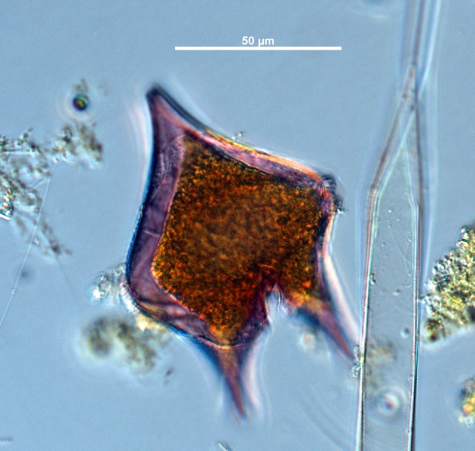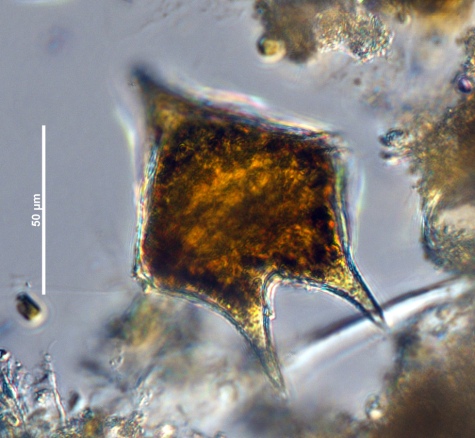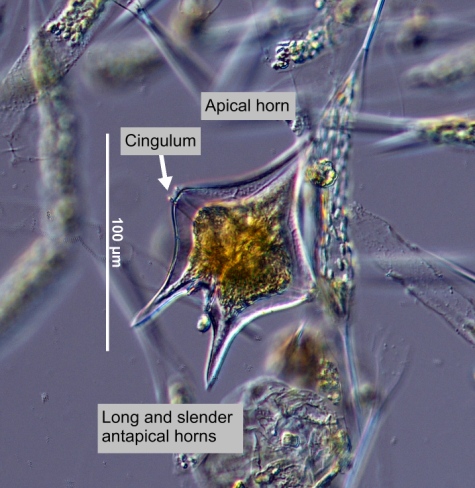


|
Synonym(s)
Peridinium oceanicum Vanhoffen 1987
Protoperidinium murray (Kofoid 1907) Hernandez Becerril 1991
(EOL 2012)
Classification
(Guiry and Guiry 2012)
Lifestyle
Cytoplasm
In a eukaryotic cell, a gel-like substance within the cell membrane that contains all the organelles except for the nucleus.
cytoplasm out of their theca in the form of a ClosePseudopodium/pseudopodia
A semi-permanent extension of the cytoplasm used for locomotion and feeding by some flagellate protozoans.
pseudopodium and engulfing the prey items. Once it has absorbed the contents of the prey, it retracts itself back into its theca. This is called ClosePallium
(feeding) A mode of feeding used by some heterotrophic dinoflagellates. The dinoflagellate extrudes its cytoplasm, engulfing its food (often a cell or chain of cells). The food is digested outside the dinoflagellate's cell. The dinoflagellate then pulls its cytoplasm and its newly digested meal back inside its theca. This method of feeding allows dinoflagellates to eat food that is bigger than itself.
pallium feeding (Menden-Deuer et al. 2005, Kraberg et al. 2010).Description
Apical
(axis, spine) The region of the apex or point. Refers to the most anterior point or region of the cell (HPP 2003).
apical CloseHorns
The apical or antapical extensions found in some armoured dinoflagellates; they contain cytoplasm, are covered in thecal plates and can be hollow or partially solid (Horner 2002).
horn and two long CloseAntapical
Referring to the most posterior point of a cell. The opposite of apical.
antapical horns (Horner 2012). The centre of the cell theca is round with a protrusion on each side (Horner 2012). The cell CloseCingulum
(dinoflagellates) "In dinokont dinoflagellates, a furrow encircling the cell one or many times" (Horner 2002). It is also known as the girdle or transverse groove and may be located at, above, or below the midpoint of the cell with the left and right ends meeting or displaced form one another (Horner 2002). In diatoms, this term describes the collective elements of a diatom girdle: "The cingulum is made up of delicate silica bands that join the two valves of a frustule. Most diatoms possess a cingulum, although some may not" (Spaulding et al. 2010).
cingulum is narrow and has wide lists. The two antapical horns are long, tubular, pointed and divergent. The left antapical horn is a bit shorter and thinner than the right. Cells have a deep CloseSulcus
"In dinokont dinoflagellates, the longitudinal area on the ventral surface that forms a furrow or depression and houses the longitudinal (trailing) flagellum" (Horner 2002).
sulcus that forms a strong indentation between the horns. The theca is CloseReticulated
Resembling a net or having a pattern that resembles a net.
reticulated with spiny junctions, making it look very ornate under CloseSEM
(scanning electron microscope) A microscope which applies "a focused beam of high-energy electrons to generate a variety of signals at the surface of solid specimens" (NSF 2011).
SEM (Evagelopoulos 2002).Measurements
Width: 150 μm
(Horner 2002)
Similar species
Harmful effects
Habitat
Distribution
Protoperidinium oceanicum is found in most of the world's warm temperate to tropical waters. It is not commonly seen in colder waters (Smithsonian 2012).
Information not available.
Growth conditions
Environmental Ranges
Temperature range (°C): 5.276 - 23.867
Nitrate (μmol L-1): 0.478 - 9.600
Salinity: 31.144 - 35.667
Oxygen (mL L-1): 4.813 - 7.455
Phosphate (μmol L-1): 0.136 - 1.129
Close
Silicic acid
A general term to describe chemical compounds containing silicon, oxygen and hydrogen with a general formula of [SiOx(OH)4-2x]n. Diatoms polymerize silicic acid into biogenic silica to form their frustules (Azam and Chisholm 1976).
Silicate (μmol L-1): 1.030 - 19.032(EOL 2012)
Bloom characteristics
References
Encyclopedia of Life (EOL). 2012. Protoperidinium oceanicum (Vanhoffen) Balech 1974. http://eol.org/pages/900875/details. Accessed 14 Mar 2012.
Evagelopoulos, A. 2002. Taxonomic notes on Protoperidinium (Peridiniales, Dinophyceae) species in the Thermaikos Bay (North Aegean Sea, Greece). Mediterranean Marine Science. 3/2: 41-54.
Guiry, M. D. and Guiry, G. M. 2012. Protoperidinium oceanicum (Vanhoffen) Balech 1974. http://www.algaebase.org/search/species/detail/?species_id=52663. Accessed 14 Mar 2012.
Horner, R. A. 2002. A Taxonomic Guide to Some Common Phytoplankton. Biopress Limited, Dorset Press, Dorchester, UK. 200.
Menden-Deuer, S., Lessard, E. J., Satterberg, J. and Grunbaum, D. 2005. Growth rates and starvation survival of three species of the pallium-feeding, thecate dinoflagellate genus Protoperidinium. Aquatic Microbial Ecology. 41: 145-152.
Smithsonian Institution. 2012. Protoperidinium oceanicum (Vanhoffen) Balech 1974. http://www.mnh.si.edu/highlight/sem/dinoflagellates.html. Accessed 14 Mar 2012.
Steidinger, K. A. and Tangen, K. 1997. Dinoflagellates. In: Tomas, C. R. (ed.) Identifying Marine Phytoplankton. Academic Press, Inc., San Diego. 429.
